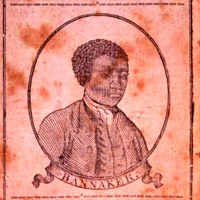Today in History: November 9

Portrait of Benjamin Banneker from the cover of his 1795 Almanac,
Courtesy of the Maryland Historical Society
I apprehend you will embrace every opportunity, to eradicate that train of absurd and false ideas and opinions, which so generally prevails with respect to us [African Americans]; and that your sentiments are concurrent with mine, which are, that one universal Father hath given being to us all; and that he hath not only made us all of one flesh, but that he hath also, without partiality, afforded us all the same sensations and endowed us all with the same faculties…Benjamin Banneker to Thomas Jefferson, August 19, 1791,
Documenting the African American Experience,
Electronic Text Center, University of Virginia Library.
Mathematician and astronomer Benjamin Banneker was born on November 9, 1731, in Ellicott's Mills, Maryland. Largely self-taught, Banneker was one of the the first African Americans to gain distinction in science. His significant accomplishments and correspondence with prominent political figures profoundly influenced how African Americans were viewed during the Federal period.
Banneker spent most of his life on his family's 100-acre farm outside Baltimore. There, he taught himself astronomy by watching the stars and learned advanced mathematics from borrowed textbooks. In 1752, Banneker garnered public acclaim by building a clock entirely out of wood. The clock, believed to be the first built in America, kept precise time for decades. Twenty years later, Banneker began making astronomical calculations that enabled him to successfully forecast a 1789 solar eclipse. His estimate, made well in advance of the celestial event, contradicted predictions of better-known mathematicians and astronomers.
Banneker's mechanical and mathematical abilities impressed many, including Thomas Jefferson who recommended him for the surveying team that laid out Washington D.C. In his free time, Banneker began compiling the Pennsylvania, Delaware, Maryland, and Virginia Almanac and Ephemeris. The almanac included information on medicines and medical treatment, and listed tides, astronomical information, and eclipses calculated by Banneker himself. He published the journal annually from 1791 to 1802.
On August 19, 1791, Banneker sent a copy of his first almanac to secretary of state Thomas Jefferson. In an accompanying letter, he questioned the slave-holder's sincerity as a "friend to liberty." Banneker urged the future president to fight for the abolition of slavery. Jefferson responded by expressing his ambivalence about slavery and endorsing Banneker's accomplishments:
No body [sic] wishes more sincerely than I do to see such proofs as you exhibit, that nature has given to our black brethren, talents equal to those of the other colours of men, and that the appearance of the want of them is owing merely to the degraded condition of their existence both in Africa and America…Thomas Jefferson to Benjamin Banneker, August 30, 1791.
Words and Deeds in American History
The future president closed by informing Banneker that he had forwarded the almanac to the French philospher the Marquis de Condorcet for the purpose of dispelling racial prejudices.
In other writings, notably Notes on the State of Virginia, Jefferson revealed conflicting perspectives on race. The Words and Deeds feature on Jefferson's letter to Banneker notes correspondence with diplomat Joel Barlow and French clergyman Henri Gregoire in which Jefferson expresses less favorable attitudes toward African Americans.
Banneker died on October 25, 1806. His accomplishments continued to inspire African-American people and provide ample evidence of African-American achievement in the sciences.
- Search the collection The African-American Experience in Ohio, 1850-1920 on Banneker to retrieve nineteenth-century materials including biographical sketches of the scientist and an oration commemorating Banneker's contributions to American history.
- Explore black America's quest for equality through the exhibition The African American Odyssey: A Quest for Full Citizenship. This on line presentation includes a section on free blacks in the antebellum period.
- Examine the map Banneker helped surveyor Andrew Ellicott create. Plan of the City of Washington in the Territory of Columbia is available in Map Collections (1500-Present).
- Learn more about Thomas Jefferson. Visit the Thomas Jefferson Papers and the special presentation American Sphinx: The Contradictions of Thomas Jefferson. Search the collection by keyword or browse the general correspondence by date.
- Read about inventors and inventions. Visit Words and Deeds in American History and browse the item list for the Science, Medicine, Exploration, and Invention, or Search the Today in History Archive on the keywords inventor or invention to find portraits of creative Americans including Samuel F.B. Morse, Elias Howe, and Henry Ford.
